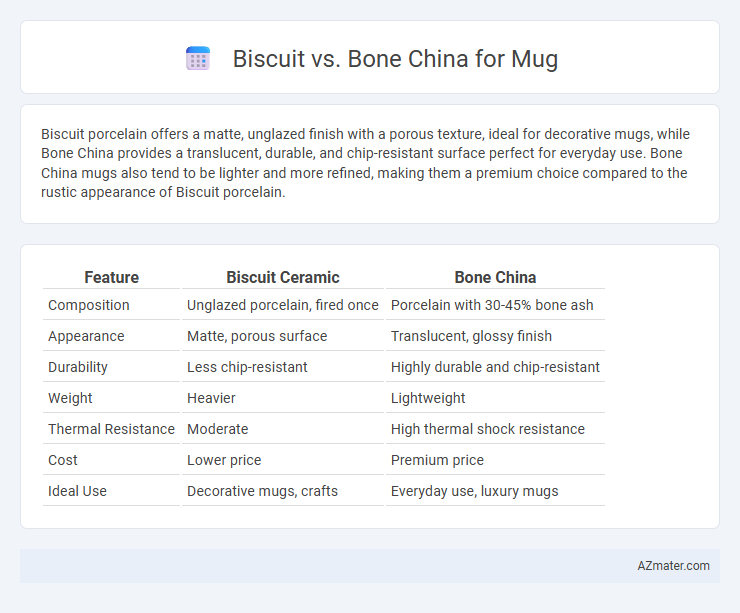Biscuit porcelain offers a matte, unglazed finish with a porous texture, ideal for decorative mugs, while Bone China provides a translucent, durable, and chip-resistant surface perfect for everyday use. Bone China mugs also tend to be lighter and more refined, making them a premium choice compared to the rustic appearance of Biscuit porcelain.
Table of Comparison
| Feature | Biscuit Ceramic | Bone China |
|---|---|---|
| Composition | Unglazed porcelain, fired once | Porcelain with 30-45% bone ash |
| Appearance | Matte, porous surface | Translucent, glossy finish |
| Durability | Less chip-resistant | Highly durable and chip-resistant |
| Weight | Heavier | Lightweight |
| Thermal Resistance | Moderate | High thermal shock resistance |
| Cost | Lower price | Premium price |
| Ideal Use | Decorative mugs, crafts | Everyday use, luxury mugs |
Introduction to Biscuit and Bone China Mugs
Biscuit mugs, known for their unglazed, matte finish, offer a porous texture that accentuates natural clay tones and provides a rustic aesthetic. In contrast, bone china mugs boast a smooth, translucent quality due to their unique composition of bone ash, feldspathic material, and kaolin, resulting in exceptional strength and chip resistance. Both materials are prized for their distinct tactile and visual properties, making them popular choices in premium mug collections.
Material Composition: Biscuit vs Bone China
Biscuit mugs are crafted from unglazed porcelain that undergoes high-temperature firing, resulting in a matte, chalky finish with a porous texture. Bone china combines fine bone ash, kaolin, and feldspar, producing a lightweight, translucent, and highly durable material with a smooth, glossy finish. The inclusion of bone ash in bone china enhances strength and whiteness compared to the more brittle and opaque biscuit porcelain.
Manufacturing Processes Compared
Biscuit mugs are created through an initial bisque firing process that hardens the clay without glazing, resulting in a porous and matte finish ideal for hand-painting. Bone china mugs undergo multiple firings, including a bisque firing followed by glazing and a final high-temperature firing, producing a translucent, durable, and non-porous surface. The inclusion of bone ash in bone china's raw materials enhances strength and whiteness, distinguishing its manufacturing complexity from the simpler biscuit production.
Visual Appearance and Aesthetic Differences
Biscuit porcelain mugs display a matte, unglazed surface that emphasizes a raw, natural texture with a soft, velvety finish, offering a rustic and artisanal aesthetic. Bone china mugs feature a translucent, glossy glaze that enhances their smooth and refined look, often showcasing intricate patterns and a delicate whiteness with a subtle translucency. The distinct visual contrast between biscuit's understated elegance and bone china's polished sophistication caters to varying aesthetic preferences for mugs.
Durability and Strength Considerations
Biscuit mugs, also known as unglazed porcelain, offer a matte finish but are generally more porous and prone to chipping compared to bone china mugs. Bone china boasts superior durability and strength due to its high levels of feldspar and bone ash, making it resistant to cracks and ideal for everyday use. The denser composition of bone china ensures better longevity and impact resistance, making it a preferred choice for durable, high-quality mugs.
Heat Retention and Performance
Bone china mugs excel in heat retention due to their dense, fine composition, which keeps beverages warmer for longer periods compared to biscuit porcelain. Biscuit mugs, being unglazed and more porous, tend to lose heat faster, impacting drinking temperature and overall performance. For optimal thermal efficiency, bone china remains the superior choice in mug materials.
Weight and Handling Experience
Bone china mugs are lighter than biscuit porcelain due to their unique composition of bone ash, providing a delicate yet durable feel that enhances handling comfort. Biscuit porcelain mugs are denser and heavier, offering a substantial grip but potentially causing fatigue during extended use. The lightweight nature of bone china makes it ideal for everyday mugs, while biscuit mugs deliver a more robust tactile experience favored in traditional settings.
Everyday Use: Staining and Cleaning
Biscuit mugs, made from unglazed porcelain, tend to absorb stains more easily and require gentle cleaning to prevent discoloration, making them less ideal for everyday use. Bone china mugs feature a glazed surface that resists staining and allows for easier cleaning, enhancing durability and maintaining their appearance over time. For daily coffee or tea drinkers, bone china offers practical benefits with superior stain resistance and straightforward maintenance.
Price and Value Comparison
Biscuit mugs typically cost less than bone china mugs due to their less intricate manufacturing process and matte finish, making them an affordable option for everyday use. Bone china mugs, known for their lightweight, durability, and translucent appearance, offer greater long-term value despite a higher initial price, often justifying the investment for collectors and those seeking premium quality. The price difference generally ranges from 20% to 50%, with bone china providing enhanced elegance and resilience that supports higher resale value and durability over time.
Which Mug is Better: Biscuit or Bone China?
Bone China mugs offer superior strength and translucency due to their high levels of bone ash, providing a lightweight yet durable option ideal for everyday use. Biscuit mugs, made from unglazed porcelain, deliver a matte finish and porous texture that enhances heat retention but can be more fragile and prone to staining. For those prioritizing elegance and resilience, Bone China is the better choice, while Biscuit is preferred for artisanal appeal and heat performance.

Infographic: Biscuit vs Bone China for Mug
 azmater.com
azmater.com